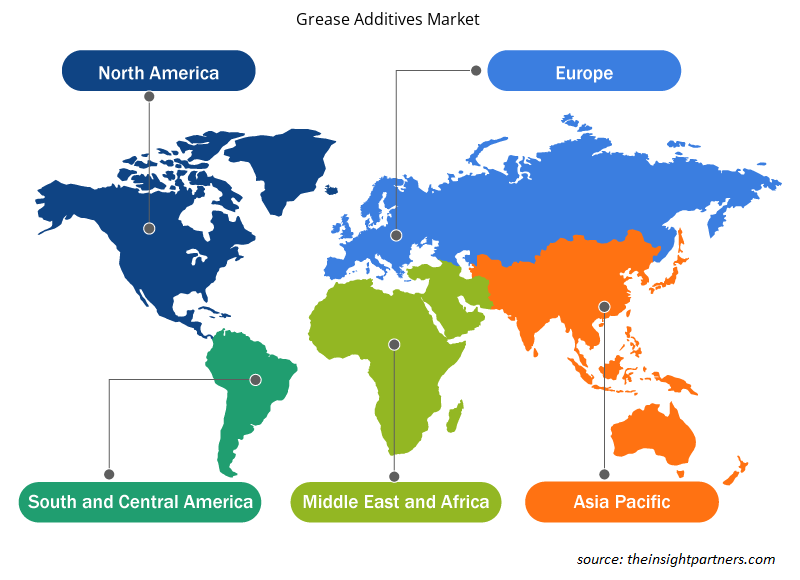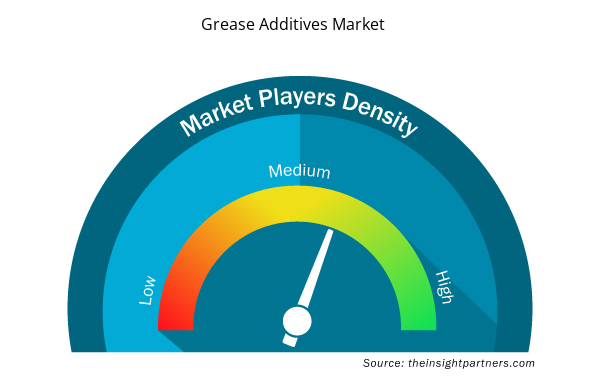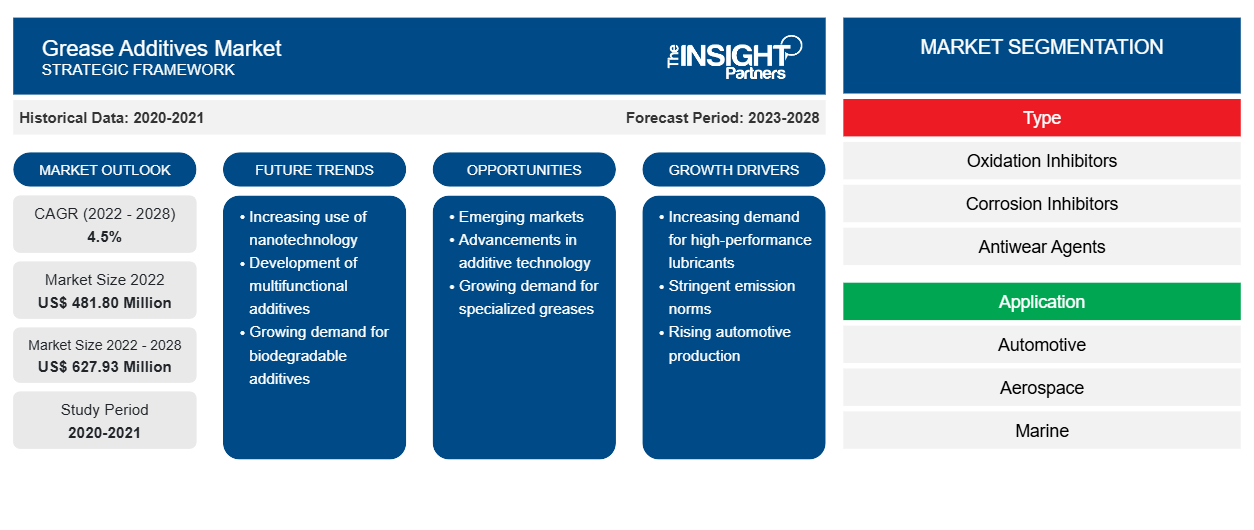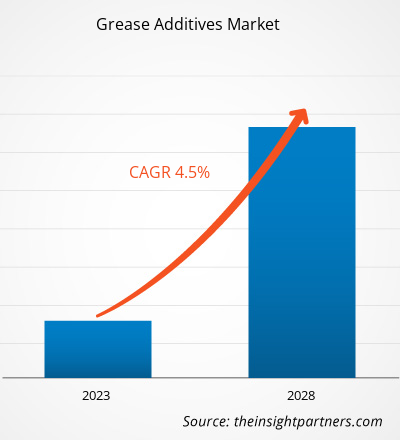[調査レポート] グリース添加剤市場規模は2022年に4億8,180万米ドルと評価され、2028年には6億2,793万米ドルに達すると予測されており、2022年から2028年にかけて4.5%のCAGRで成長すると予測されています。
グリース添加剤は、固体として油に溶解または懸濁している有機または無機の化学物質です。乗用車および商用車の販売の急増により、グリース添加剤市場が牽引されています。グリース添加剤は、機器の性能を向上させ、寿命を延ばすために潤滑剤として使用されるグリースに使用されます。
工業用グリースは、主に基油、増粘剤、添加剤で構成されており、添加剤は基油に次いで 2 番目に重要な成分です。グリース製造には、鉱油、植物油、合成油の 3 種類の基油が使用されます。合成グリースは、ポリアルファオレフィンなどの合成油を使用して製造されます。これらは、特に自動車産業などの産業分野で広く使用されています。優れた特性、動作の一貫性を誘発する能力、および手頃な価格により、合成グリースは潤滑剤の好ましいカテゴリになっています。合成グリースは、極端な温度、負荷、および速度を伴う用途で使用されます。合成グリース添加剤は、粘度指数を高め、揮発性を低下させ、潤滑剤の流動点を下げることで、物理的および化学的特性を強化します。粘度指数向上剤、流動点降下剤、分散剤、および洗浄剤は、広く使用されている添加剤のカテゴリの一部です。合成グリースの需要が高まるにつれて、これらのグリース用の添加剤の必要性は、予測期間中に急増する可能性があります。
いくつかの大手市場プレーヤーは、合成グリースの効率を向上させる添加剤を開発しています。たとえば、2022年9月、クラリアントは、機械の効率を高める完全合成金属加工液用の極圧/耐摩耗添加剤、潤滑性向上剤、腐食防止剤、中和剤、ガイド配合を発売しました。このように、合成グリースの需要が高まるにつれて、これらのグリースに使用される添加剤は、グリース添加剤市場に新たなトレンドをもたらしています。
2022年には、アジア太平洋地域がグリース添加剤市場で最大のシェアを占め、予測期間中に最高のCAGRを記録すると予測されています。ヨーロッパも魅力的な地域であり、市場で大きなシェアを占めています。陸上および洋上風力発電所の設置の増加と自動車製造規模の拡大は、ヨーロッパでのグリース添加剤市場の成長に貢献しています。スウェーデン、フィンランド、ドイツ、フランスでは、再生可能エネルギーの需要の高まりと相まって、風力タービンの設置が著しく増加しています。WindEurope VZW / ASBLによると、ヨーロッパでは2022年に陸上で約16.7GW、洋上プロジェクトで2.5GWを含む19.1GWの新しい風力発電設備が記録されました。グリースは、腐食、熱、天候、炎への耐性を高めるため、風力タービンの性能を高めるために使用されます。
要件に合わせてレポートをカスタマイズする
このレポートの一部、国レベルの分析、Excelデータパックなど、あらゆるレポートを無料でカスタマイズできます。また、スタートアップや大学向けのお得なオファーや割引もご利用いただけます。
- このレポートの主要な市場動向を入手してください。この無料サンプルには、市場動向から見積もりや予測に至るまでのデータ分析が含まれます。
COVID-19パンデミックがグリース添加剤市場に与える影響
COVID-19パンデミックは、世界中のいくつかの国の経済と産業に影響を及ぼしました。北米、ヨーロッパ、アジア太平洋(APAC)、中南米、中東アフリカ(MEA)でのロックダウン、旅行制限、事業停止は、自動車、建設、航空宇宙、鉱業を含むいくつかの産業の成長を妨げました。製造ユニットの停止は、世界のサプライチェーン、製造活動、納期、必須および非必須の製品の販売を妨げました。2020年には、さまざまな企業で製品の納品が遅れ、製品の販売が低迷しました。さらに、ヨーロッパ、アジア太平洋、北米のさまざまな国の政府が海外旅行を禁止したため、企業はコラボレーションやパートナーシップの計画を一時的に中止せざるを得ませんでした。これらすべての要因が2020年と2021年初頭にさまざまな産業を妨げ、グリース添加剤市場を含む複数の市場の成長を抑制しました。
COVID-19パンデミックの初期段階では、ロックダウン制限の実施と製造ユニットのシャットダウンにより生産不足につながり、需要と供給のギャップが生じました。これらの要因により、さまざまな小規模および大規模グリース添加剤メーカーの収益性が損なわれました。2021年には、さまざまな国の政府が以前に課された制限の緩和を発表し、いくつかの経済が再開し、世界市場が活性化しました。メーカーはフル稼働を許可されたため、需要と供給のギャップやその他の影響を克服することができました。COVID-19パンデミック後の自動車および産業機械の需要の高まりにより、グリース添加剤の需要が生まれています。
市場分析
主要企業による戦略的開発がグリース添加剤市場の成長を後押し
市場の主要企業は、製品の発売、合併や買収、コラボレーションなど、市場の成長に有利なさまざまなマーケティング戦略の採用に取り組んでいます。
タイプインサイト
タイプに基づいて、グリース添加剤市場は、酸化防止剤、腐食防止剤、耐摩耗剤、圧力添加剤、金属不活性化剤、その他に分類されます。 2022年には、酸化防止剤セグメントが最大の市場シェアを占めました。 圧力添加剤セグメントは、予測期間中に最高のCAGRを記録すると予想されます。 圧力添加剤セグメントのグリース添加剤市場の成長は、航空宇宙、海洋、鉱業、製鉄所など、高圧条件のアプリケーションでのグリースの需要の増加に起因しています。 さらに、さまざまなアプリケーションで機械的摩耗の発生が増加しているため、適切なグリース添加剤を補充した効果的なグリース潤滑剤の必要性が強調されています。
Afton Chemical Corp、BASF SE、Clariant AG、Croda International plc、Evonik Industries AG、Shamrock Technologies Inc、The Lubrizol Corp、RT Vanderbilt Holding Co Inc、Lanxess AG、および IPAC Inc は、グリース添加剤市場で事業を展開している主要企業です。これらの企業は、市場規模を拡大し、新興市場のトレンドを追うために、主に製品の革新に重点を置いています。
グリース添加剤市場の地域別分析
予測期間を通じてグリース添加剤市場に影響を与える地域的な傾向と要因は、Insight Partners のアナリストによって徹底的に説明されています。このセクションでは、北米、ヨーロッパ、アジア太平洋、中東、アフリカ、南米、中米にわたるグリース添加剤市場のセグメントと地理についても説明します。

- グリース添加剤市場の地域別データを入手
グリース添加剤市場レポートの範囲
| レポート属性 | 詳細 |
|---|---|
| 2022年の市場規模 | 4億8,180万米ドル |
| 2028年までの市場規模 | 6億2,793万米ドル |
| 世界のCAGR(2022年 - 2028年) | 4.5% |
| 履歴データ | 2020-2021 |
| 予測期間 | 2023-2028 |
| 対象セグメント | タイプ別
|
| 対象地域と国 | 北米
|
| 市場リーダーと主要企業プロフィール |
|
グリース添加剤市場のプレーヤー密度:ビジネスダイナミクスへの影響を理解する
グリース添加剤市場は、消費者の嗜好の変化、技術の進歩、製品の利点に対する認識の高まりなどの要因により、エンドユーザーの需要が高まり、急速に成長しています。需要が高まるにつれて、企業は提供品を拡大し、消費者のニーズを満たすために革新し、新たなトレンドを活用し、市場の成長をさらに促進しています。
市場プレーヤー密度とは、特定の市場または業界内で活動している企業または会社の分布を指します。これは、特定の市場スペースに、その市場規模または総市場価値に対してどれだけの競合相手 (市場プレーヤー) が存在するかを示します。
グリース添加剤市場で事業を展開している主要企業は次のとおりです。
- アフトンケミカル社
- BASF SE
- クラリアントAG
- クローダインターナショナル
- エボニック インダストリーズ AG
免責事項:上記の企業は、特定の順序でランク付けされていません。

- グリース添加剤市場のトップキープレーヤーの概要を入手
レポートの注目点
- グリース添加剤市場における進歩的な業界動向は、企業が効果的な長期戦略を策定する上で役立ちます。
- 先進国と発展途上国のグリース添加剤市場のプレーヤーが採用しているビジネス成長戦略
- 2020年から2028年までの市場の定量分析
- グリース添加剤の世界需要の推定
- グリース添加剤市場におけるバイヤーとサプライヤーの有効性を示すポーターの5つの力の分析
- 競争市場の状況を理解するための最近の動向
- グリース添加剤市場の成長を牽引または抑制する市場動向と展望
- 商業的利益を支える市場戦略を強調することで意思決定プロセスを支援する
- グリース添加剤市場の規模
- グリース添加剤業界の市場と成長動向の詳細な概要とセグメンテーション
- 有望な成長機会のあるさまざまな地域のグリース添加剤市場の規模
- 過去2年間の分析、基準年、CAGRによる予測(7年間)
- PEST分析とSWOT分析
- 市場規模価値/数量 - 世界、地域、国
- 業界と競争環境
- Excel データセット



Report Coverage
Revenue forecast, Company Analysis, Industry landscape, Growth factors, and Trends

Segment Covered
This text is related
to segments covered.

Regional Scope
North America, Europe, Asia Pacific, Middle East & Africa, South & Central America

Country Scope
This text is related
to country scope.
よくある質問
The major players operating in the global grease additives market are Afton Chemical Corp, BASF SE, Clariant AG, Croda International plc, Evonik Industries AG, Shamrock Technologies Inc, The Lubrizol Corp, RT Vanderbilt Holding Co Inc, Lanxess AG, and IPAC Inc.
The renewable energy industry, a subsegment of the power sector, is emerging as a prominent consumer of industrial greases. Grease is primarily used in turbines and transformers in this industry. In recent years, the increasing demand for renewable energy has led to an upsurge in wind turbine installations worldwide. The IEA states that 830 GW of wind capacity was installed globally as of 2021, of which 93% were onshore systems while 7% were offshore wind farms.
Asia Pacific accounted for the largest share of the global grease additives market. Asia Pacific is one of the most significant regions for the grease additives market owing to growth in operations of industries such as automotive, wind energy, marine, aerospace, and construction, along with increased grease production.
Based on application, construction machinery segment is projected to grow at the fastest CAGR over the forecast period. The growth of the segment is attributed to growing construction activities in emerging economies and rising renovation activities.
The automotive industry has witnessed tremendous growth over the last few decades and is expected to rise steadily during the forecast period. According to a report published by the European Automobile Manufacturers’ Association (ACEA), global motor vehicle production increased by 1.3% from 2020 to 2021; 79.1 million motor vehicles, including 61.6 million passenger cars, were produced across the world in 2021. Thus, an upsurge in automobile manufacturing and the growing adoption of electric vehicles boost the demand for grease, thereby bolstering the grease additives market growth.
Based on type, oxidation inhibitors segment held the largest revenue share. The growth of the segment is attributed to increasing demand from various end use industries including aerospace, automotive, mining, construction machinery, and others.
Trends and growth analysis reports related to Chemicals and Materials : READ MORE..
The List of Companies - Grease Additives Market
- Afton Chemical Corp
- BASF SE
- Clariant AG
- Croda International Plc
- Evonik Industries AG
- Shamrock Technologies Inc
- The Lubrizol Corp
- RT Vanderbilt Holding Co Inc
- Lanxess AG
- IPAC Inc
The Insight Partners performs research in 4 major stages: Data Collection & Secondary Research, Primary Research, Data Analysis and Data Triangulation & Final Review.
- Data Collection and Secondary Research:
As a market research and consulting firm operating from a decade, we have published and advised several client across the globe. First step for any study will start with an assessment of currently available data and insights from existing reports. Further, historical and current market information is collected from Investor Presentations, Annual Reports, SEC Filings, etc., and other information related to company’s performance and market positioning are gathered from Paid Databases (Factiva, Hoovers, and Reuters) and various other publications available in public domain.
Several associations trade associates, technical forums, institutes, societies and organization are accessed to gain technical as well as market related insights through their publications such as research papers, blogs and press releases related to the studies are referred to get cues about the market. Further, white papers, journals, magazines, and other news articles published in last 3 years are scrutinized and analyzed to understand the current market trends.
- Primary Research:
The primarily interview analysis comprise of data obtained from industry participants interview and answers to survey questions gathered by in-house primary team.
For primary research, interviews are conducted with industry experts/CEOs/Marketing Managers/VPs/Subject Matter Experts from both demand and supply side to get a 360-degree view of the market. The primary team conducts several interviews based on the complexity of the markets to understand the various market trends and dynamics which makes research more credible and precise.
A typical research interview fulfils the following functions:
- Provides first-hand information on the market size, market trends, growth trends, competitive landscape, and outlook
- Validates and strengthens in-house secondary research findings
- Develops the analysis team’s expertise and market understanding
Primary research involves email interactions and telephone interviews for each market, category, segment, and sub-segment across geographies. The participants who typically take part in such a process include, but are not limited to:
- Industry participants: VPs, business development managers, market intelligence managers and national sales managers
- Outside experts: Valuation experts, research analysts and key opinion leaders specializing in the electronics and semiconductor industry.
Below is the breakup of our primary respondents by company, designation, and region:

Once we receive the confirmation from primary research sources or primary respondents, we finalize the base year market estimation and forecast the data as per the macroeconomic and microeconomic factors assessed during data collection.
- Data Analysis:
Once data is validated through both secondary as well as primary respondents, we finalize the market estimations by hypothesis formulation and factor analysis at regional and country level.
- Macro-Economic Factor Analysis:
We analyse macroeconomic indicators such the gross domestic product (GDP), increase in the demand for goods and services across industries, technological advancement, regional economic growth, governmental policies, the influence of COVID-19, PEST analysis, and other aspects. This analysis aids in setting benchmarks for various nations/regions and approximating market splits. Additionally, the general trend of the aforementioned components aid in determining the market's development possibilities.
- Country Level Data:
Various factors that are especially aligned to the country are taken into account to determine the market size for a certain area and country, including the presence of vendors, such as headquarters and offices, the country's GDP, demand patterns, and industry growth. To comprehend the market dynamics for the nation, a number of growth variables, inhibitors, application areas, and current market trends are researched. The aforementioned elements aid in determining the country's overall market's growth potential.
- Company Profile:
The “Table of Contents” is formulated by listing and analyzing more than 25 - 30 companies operating in the market ecosystem across geographies. However, we profile only 10 companies as a standard practice in our syndicate reports. These 10 companies comprise leading, emerging, and regional players. Nonetheless, our analysis is not restricted to the 10 listed companies, we also analyze other companies present in the market to develop a holistic view and understand the prevailing trends. The “Company Profiles” section in the report covers key facts, business description, products & services, financial information, SWOT analysis, and key developments. The financial information presented is extracted from the annual reports and official documents of the publicly listed companies. Upon collecting the information for the sections of respective companies, we verify them via various primary sources and then compile the data in respective company profiles. The company level information helps us in deriving the base number as well as in forecasting the market size.
- Developing Base Number:
Aggregation of sales statistics (2020-2022) and macro-economic factor, and other secondary and primary research insights are utilized to arrive at base number and related market shares for 2022. The data gaps are identified in this step and relevant market data is analyzed, collected from paid primary interviews or databases. On finalizing the base year market size, forecasts are developed on the basis of macro-economic, industry and market growth factors and company level analysis.
- Data Triangulation and Final Review:
The market findings and base year market size calculations are validated from supply as well as demand side. Demand side validations are based on macro-economic factor analysis and benchmarks for respective regions and countries. In case of supply side validations, revenues of major companies are estimated (in case not available) based on industry benchmark, approximate number of employees, product portfolio, and primary interviews revenues are gathered. Further revenue from target product/service segment is assessed to avoid overshooting of market statistics. In case of heavy deviations between supply and demand side values, all thes steps are repeated to achieve synchronization.
We follow an iterative model, wherein we share our research findings with Subject Matter Experts (SME’s) and Key Opinion Leaders (KOLs) until consensus view of the market is not formulated – this model negates any drastic deviation in the opinions of experts. Only validated and universally acceptable research findings are quoted in our reports.
We have important check points that we use to validate our research findings – which we call – data triangulation, where we validate the information, we generate from secondary sources with primary interviews and then we re-validate with our internal data bases and Subject matter experts. This comprehensive model enables us to deliver high quality, reliable data in shortest possible time.


 このレポートの無料サンプルを入手する
このレポートの無料サンプルを入手する